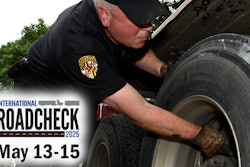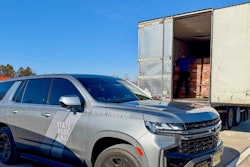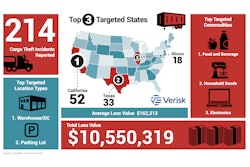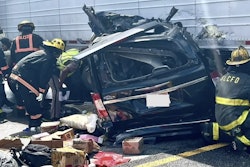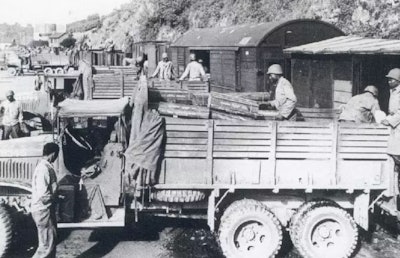
Editor's Note: During this, Black History Month, it's the right time to look at how Black soldiers played an important role in one of the most famous of military trucking operations, the Red Ball. Express.
-----

Most of the men risking their lives driving those trucks along rough, narrow French roads were Black. At that time, the U.S. armed services were still segregated, and Black soldiers were not allowed to serve in combat. Instead, Blacks in uniform were assigned to supply units, loading and unloading equipment, food, fuel and other supplies.
After landing at Normandy, Allied forces struggled against heavily fortified German troops. But, in early August, Allied troops, especially Gen. George Patton's 3rd Army began advancing quickly ... almost too quickly as they often outran their supply lines. This gave rise to the plan that would become known as The Red Ball Express.
In late August, two roads, one northbound and the other southbound, were set aside strictly for convoys of trucks to shuttle supplies to the frontline troops. The northbound road carried loaded trucks, and the southbound was for those returning to be refilled. The two routes were marked with red balls, said to have been similar to the red balls used by the Santa Fe railroad to mark priority and perishable freight in the late 1890s.
Accounts of driving these roads proved that may not have been the same as serving in combat units on the front lines, but it was far from easy duty.
Each truck to run these two Red Ball roads was staffed by two soldiers. They took turns driving and only stopped for brief breaks about once every two hours, and for refueling and repairs. Military police officers stationed along the two Red Ball roads kept other vehicles off them and directed traffic at intersections and in villages.
The plan called for convoys of five fully-loaded trucks accompanied front and back by Jeeps. However, given the need for haste in getting supplies delivered, many drivers simply took off on their own. The trucks were supposed to travel at just 25 mph, but some creative drivers disengaged their trucks' governors and sped along at 50 mph when possible.
The trucks -- mostly two and a half ton GMC models (aka Deuce and a Half Jimmies) and some smaller Dodge trucks -- were sometimes easy targets for German aircraft. At night, drivers were ordered to use so called "cat's eye" headlights that provided little illumination but were less likely to be seen by aircraft.
The other enemies of Red Ball drivers were fatigue and equipment breakdown. With the admonition to "Keep 'em Rolling", drivers kept their trucks moving as many as 20 hours a day. Stopping only to sleep by the roadside most of the time. Mud, rough terrain and a punishing schedule took their tolls on the Jimmies' tires and brakes.
Still, the soldier/trucks running the Red Ball roads made sure the troops and armor on the front lines were properly supplied until other routes were created, ports were reopened and French railroads, heavily damaged by bombers before D-Day, began running again.
In late November of 1945, the Red Ball Express was discontinued and its trucks and drivers reassigned. However, in the short span of time they drove, the men of the Red Ball Express delivered more than 412,000 tons of supplies.






